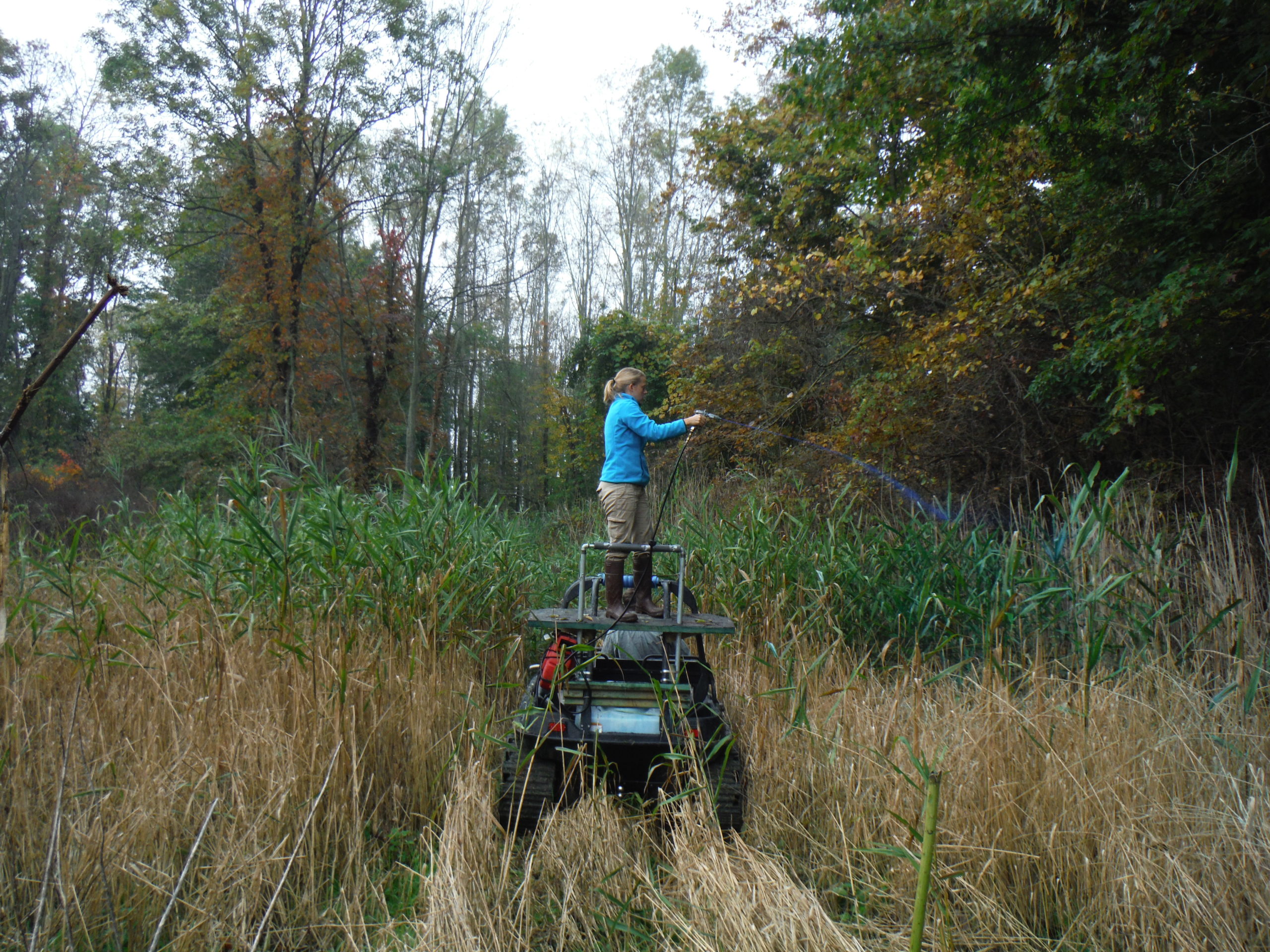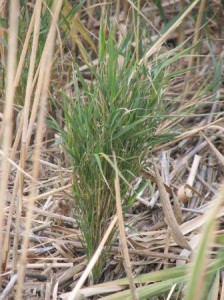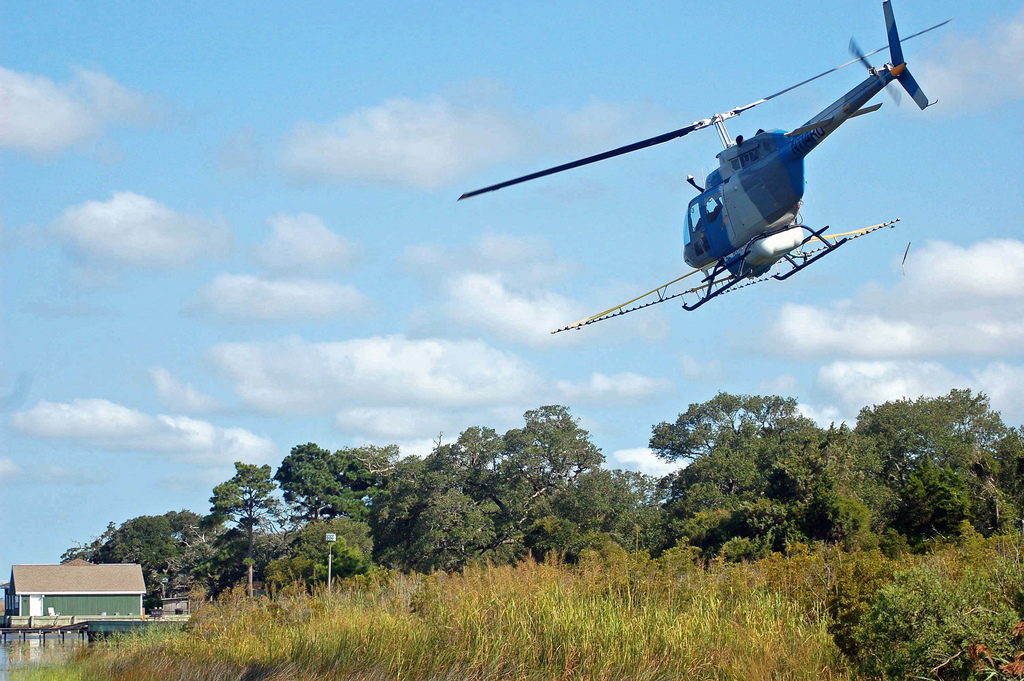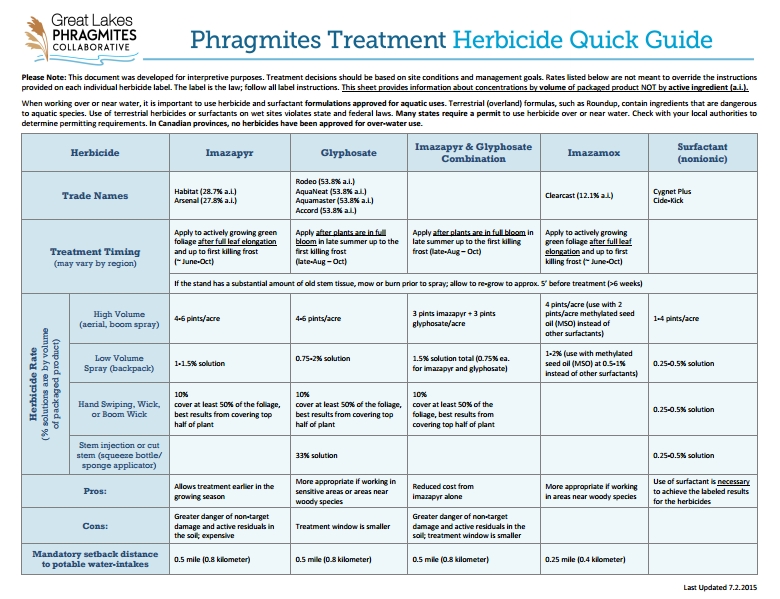Managing Phragmites with Herbicide
Herbicide can be the most effective method of non-native Phragmites management when it is used as a component of a comprehensive and integrated management approach.

There are at least two herbicides (glyphosate and imazapyr) that are effective at managing non-native Phragmites stands and are commercially available under a variety of names in the United States and Canada. These chemicals are not species specific, so care must be taken to avoid harming native plants. Imazapyr remains active in the soil longer than glyphosate, and therefore, can have greater non-target impacts if used in areas with greater plant diversity. Additionally, different chemical formulations are available for application over land and over water. It is important to use the formulation approved for aquatic use, because overland formulas can harm amphibians, fish, and invertebrates. For more information about herbicide impacts on amphibians and reptiles, see p. 19-20 and 71-72 of the Michigan Amphibian & Reptile Best Management Practices document.

Phragmites “witches broom” regrowth after Glyphosate treatment of the stand at Harsens Island, MI. Photo credit: phragmites.org
When using herbicide to manage non-native Phragmites, if the entire clone is not killed, the remaining rhizomes may produce new stems the following year. In some cases, these take the form of a “witches broom” growth, with many small stems growing from a single node that may be buried or exposed. Resprouting stalks and witches brooms require follow-up herbicide treatment.
Regulations on the application of herbicides are different across the country and between the U.S. and Canada. Check with local authorities before purchasing and applying herbicides. Methods used to apply herbicide vary depending on the size of the area requiring treatment, the density of the Phragmites stands, the composition of the surrounding vegetation, and the capacity of the management team.
For more information on herbicide application see: A guide to the control and management of invasive Phragmites by the Michigan Department of Environment, Great Lakes, and Energy (EGLE).
Phragmites Herbicide Treatment Quick Guide
| Links to Herbicide and Surfactant Labels | ||
The Non-native Phragmites Herbicide Quick Guide provides an easy reference sheet for mixing the correct quantities of herbicide for non-native Phragmites management. This one-page (double-sided) guide can be printed and left in work trucks or with mixing equipment. It will be updated as new research improves management best practices.
Sources and Additional Information:
- Aquatic Invasive Species: Phragmites (Michigan EGLE)
- A Guide to the Control and Management of Invasive Phragmites: Third Edition (Michigan EGLE/DNR)
- Herbicide Reference Guide for Landowners (Larimer County Weed District) – This PDF has information on calibrating spray equipment, including handguns and boom sprayers
- Phragmites Management Michigan State Parks – Webinar (Ray Fahlsing and Bob Clancy, MI DNR)
- Ontario Phragmites Best Management Practices Guide (2021)
Herbicide Links by State and Province

The Great Lakes states and provinces have many regulations and standards for herbicide and pesticide treatments that can be explored in detail on the websites below (including lists of approved herbicides, permitting information, and applicator licensing). There are often multiple agencies involved in permitting for herbicide applications, especially in or over water; the below list may not be exhaustive. Please contact your state or provincial agencies for more information. If you know of additional or updated resources, please email phragmites@glc.org.
The necessity for a permit may depend on many factors including proximity to standing water, wetlands, and Great Lakes shoreline.
US Resources
Illinois
Indiana
Michigan
- State of Michigan chemicals used for treatment (approved and not approved herbicides)
- Michigan Agriculture and Rural Development – Pesticide application
- Michigan Department of Environment, Great Lakes, and Energy -Aquatic Nuisance Control – Permitting
Minnesota
- Minnesota Department of Agriculture – Pesticide Overview
- Minnesota’s Aquatic Plant Management Program
- Minnesota Pollution Control Agency – Pesticide NPDES permits
New York
Ohio
Pennsylvania
- Pennsylvania Department of Agriculture – Pesticide program
- Pennsylvania Department of Environmental Protection – Pesticides
Wisconsin
- State of Wisconsin Department of Agriculture, Trade, and Consumer Protection – Licensing
- Department of Agriculture, Trade, and Consumer Protection – Pesticide database
Canadian Resources
Ontario
Quebec

